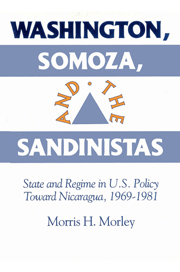Book contents
- Frontmatter
- Contents
- Acknowledgments
- 1 Introduction: Permanent and transitory interests in U.S. foreign policy
- 2 Washington and the Somoza dynasty: From consolidation to crisis of a client dictatorship
- 3 Supporting Somoza: Substance and symbol in American policy during the Nixon-Ford era
- 4 The Carter administration and Nicaragua: Human rights and the politics of accommodation
- 5 The Carter administration and Nicaragua: Mediation and the politics of frustration
- 6 Washington ruptures a historic relationship: Dumping the dictator to save the state
- 7 The Carter administration and revolutionary Nicaragua: Containing Sandinista power
- 8 Conclusion
- Bibliography
- Index
3 - Supporting Somoza: Substance and symbol in American policy during the Nixon-Ford era
Published online by Cambridge University Press: 31 March 2010
- Frontmatter
- Contents
- Acknowledgments
- 1 Introduction: Permanent and transitory interests in U.S. foreign policy
- 2 Washington and the Somoza dynasty: From consolidation to crisis of a client dictatorship
- 3 Supporting Somoza: Substance and symbol in American policy during the Nixon-Ford era
- 4 The Carter administration and Nicaragua: Human rights and the politics of accommodation
- 5 The Carter administration and Nicaragua: Mediation and the politics of frustration
- 6 Washington ruptures a historic relationship: Dumping the dictator to save the state
- 7 The Carter administration and revolutionary Nicaragua: Containing Sandinista power
- 8 Conclusion
- Bibliography
- Index
Summary
Introduction
Throughout the presidencies of Richard Nixon and Gerald Ford, American policymakers perceived Somoza as a viable dictator firmly in control of the Nicaraguan state and society, and promoting U.S. permanent interests. This despite increasing business sector hostility toward the regime's economic policies, the growth of a politically heterogeneous opposition movement, Somoza's willingness to use excessive force against peasant noncombatants in areas of guerrilla concentrations, and the appearance of institutional conflicts within the National Guard.
Toward the end of the 1960s, National Guard officers became embroiled in a divisive controversy over the twin issues of promotions and corruption. Many junior officers directed their criticism at Somoza himself over alleged favoritism toward family members, close cronies, and less-qualified individuals at the expense of younger, more professionally oriented officers and military academy graduates. But these conflicts had little or no impact on the overall cohesiveness of the Guard as a military organization capable of waging war against domestic opponents in the most efficient and ruthless fashion. In July 1969, amid disagreements among the officer corp, it “crushed” the Managua base of the Sandinista National Liberation Front (FSLN), the last in a series of major military defeats suffered by the guerrillas at the hands of Somoza's praetorian army since the early years of the decade.
Confronting the formidable task of rebuilding its military capacities and establishing an organized mass political following, the FSLN moved its center of operations to the countryside in 1970 – to the large provincial towns (Masaya, Grenada, Carazo, Rivas) where it could operate out of the shadow of the regime's military-police force (Managua).
- Type
- Chapter
- Information
- Washington, Somoza and the SandinistasStage and Regime in US Policy toward Nicaragua 1969–1981, pp. 62 - 87Publisher: Cambridge University PressPrint publication year: 1994



